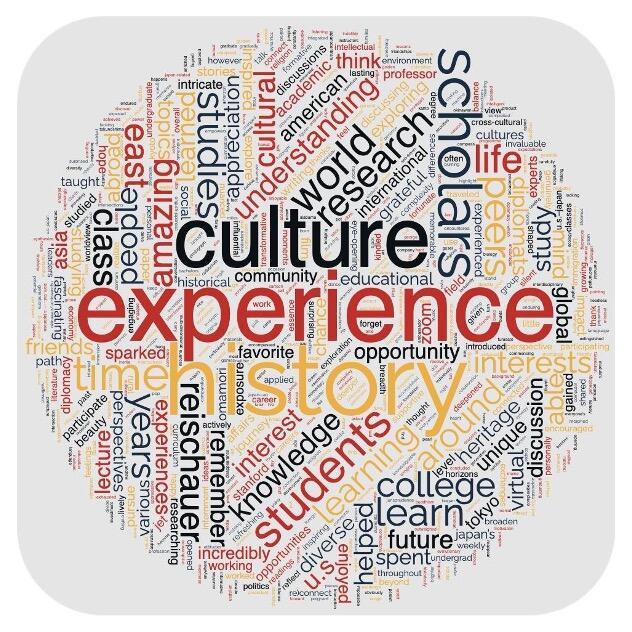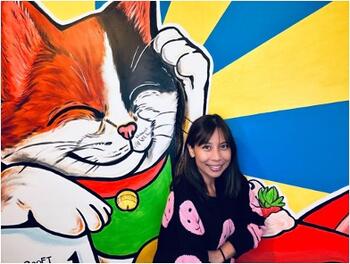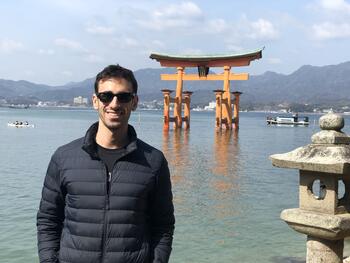Dr. Mariko Yang-YoshiharaˇŻs Yatsuhashi (ˇ°Eight Bridgesˇ±)
During a visit to Okayama Prefecture in 2019, members of the Okayama Prefectural Board of Education kindly brought me to Korakuen Garden, one of JapanˇŻs three most celebrated gardens that dates back to the 17th century. I was especially struck by a unique bridge called Yatsuhashi (ˇ°eight bridgesˇ±), that consists of eight planks used to cross a pond. The name ˇ°yatsuhashiˇ± comes from the Heian period (794 to 1185) collection of poems and narratives, The Tales of Ise.

When I think of the academic and professional pathways taken by Mariko Yang-Yoshihara, who works as an instructor and an education researcher for 91łÔąĎ, I think of Yatsuhashi, which I crossed in Korakuen Garden. (Photo above: Yatsuhashi at Korakuen, Okayama; photo courtesy Gary Mukai.)
As a graduate of the all-girls Sacred Heart Schools in Tokyo, she was nurtured to think as a global citizen and remain committed to the promotion of womenˇŻs empowerment. Since obtaining a B.A. in Literature from the University of the Sacred Heart in Japan, she has stayed actively engaged in the alumni network. I think of her years at the Sacred Heart institutions in Tokyo as the first academic plank that she crossed, navigating herself into the wider world.
The second academic plank that she crossed was in the United States where she earned a B.A. in Political Science from the University of California, Irvine, and an M.A. and a PhD in Political Science from 91łÔąĎ. Her dissertation focused on the administration of JapanˇŻs technology and science policy, and her PhD advisor was . Yang-YoshiharaˇŻs encounter with the ecosystem and educational approaches in Silicon Valley has laid the foundation of her commitment to cultivating the future generation of innovative and empathetic thinkers. To put it differently, her focus on innovation and education form the materials that make up the many planks that she would traverse in the subsequent years.
In 2016, she co-founded with (PhD, Stanford, 2013) , a non-profit organization which provides educational programs that embrace design thinking as a pedagogical approach, aiming to foster empathy, promote humanistic perspectives, and inspire youths to become change makers. SKY LaboˇŻs inquiry-based program, designed to challenge the STEM gender gap in Japan and shift the perceptions of young women toward technology and engineering, obtained official support from the Gender Equality Bureau of JapanˇŻs Cabinet Office in 2019 and received the Semi-Grand Prix of Nissan FoundationˇŻs Rikajyo Ikusei Sho (Award Promoting the Next Generation of Women in STEM) in August 2022. Yang-Yoshihara co-authored with Kijima a book on STEAM education and design thinking, ĘŔ˝ç¤ň‰ä¤¨¤ëł§°Ő·ˇ´ˇ˛ŃČ˲ĨDĄ·ĄęĄłĄóĄĐĄě©`ˇ¸ĄÇĄ¶Ą¤ĄóËĽżĽˇą¤ÎşËĐÄ, which was published by Asahi Shinbun Press in 2019. The book is in its second printing and was translated into the Chinese language as ąčąČĘÇČçşÎĹŕŃř´´ĐÂČË˛ĹµÄ by the Zhejiang PeopleˇŻs Publishing House (Őă˝ČËĂńłö°ćÉç) in 2021. I see SKY Labo serving as the third plank of yatsuhashi that she is traversing.
Also in 2016, Yang-Yoshihara co-organized the Stanford-Silicon Valley U.S.-Japan Dialogue: Womenomics, the Workplace, and Women and published the . This conference and final reportˇŞwhich I see as her fourth plankˇŞwas with the or Shorenstein APARC, where she had once worked as a doctoral researcher, a recipient of the Barbara Hillman Research Fellowship, and a third term participant of the Asia Pacific Scholars Program. She continues to collaborate with many of the conference presenters and also , Japan Program Director, Shorenstein APARC.
Since joining 91łÔąĎ in 2019, Yang-Yoshihara has utilized inquiry-based pedagogy to design, develop, and teach innovative online courses and seminars on subjects including social entrepreneurship, gender equity, and sustainability. Mariko designed and co-instructs the Stanford-Hiroshima Collaboration Project on Entrepreneurship (SHCPE), a graduate course for the Hiroshima Business Management School at the Prefectural University of Hiroshima. She has also developed a course on entrepreneurship and sustainability education in collaboration with Eikei University, Hiroshima PrefectureˇŻs new liberal arts college. She also served as the inaugural instructor and now as an advisor to Stanford e-Eiri, a high school course that explores the United Nations Sustainable Development Goals (SDGs) with a special focus on gender equity. The current Stanford e-Eiri instructor is Mia Kimura. I see Yang-YoshiharaˇŻs teaching engagements at 91łÔąĎ as the fifth plank of her yatsuhashi.
In addition to her role at 91łÔąĎ, Yang-Yoshihara is a Visiting Professor at Tohoku University, serving as a faculty member of the School of Engineering and an academic advisor to graduate students in the Department of Management Science and Technology. She gives lectures to engage JapanˇŻs future engineers and aspiring scientists to think at the crossroads of STEM and humanities, an approach she calls STEAM. This sixth plank illustrates how she tries to transmit her knowledge and experiences to inspire the next generation beyond the 91łÔąĎ audiences.

Her research has been guided by a keen curiosity at the intersection between innovation and education. Her scholarly works can be found in volumes by academic publishers such as the MIT Press and the Tokyo University Press, as well as in peer-reviewed journals including the International Journal of STEM Education, Thinking Skills and Creativity, and Administrative Sciences. Most recently, she co-edited The Emerald Handbook of Research Management and Administration Around the World (2023, Emerald Publishing), collaborating with Dr. Simon Kerridge (University of Kent) and Dr. Susi Poli (University of Bologna). This book stands as the most comprehensive work to date on professionals in research management and administration (RMAs), providing insights and observations offered by 127 researchers and practitioners representing 50 countries across Africa, North America, South America, Asia, Australasia, Eastern Europe, Western Europe, and the Middle East. Evident in the unprecedented scale of the book is Yang-YoshiharaˇŻs aspiration to contribute to the future generation of innovative change-makers. The ebook edition is Open Access and . This seventh plank that she is navigating, focusing on research, is quickly expanding with participation from people worldwide. (The book cover above was reproduced with permission from Emerald Publishing Limited.)
As for the eighth plank, I am very much looking forward to what lies ahead as she continues to drive ideas where education, innovation, and research intersect.
Read More
University of the Sacred Heart in Japan and 91łÔąĎ alumna serves as a bridge to students and scholars in Japan and other parts of the world.






































